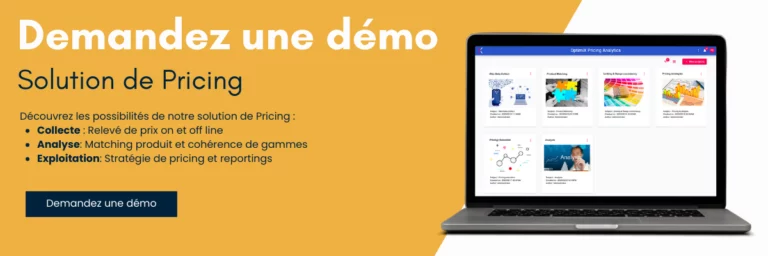Market penetration and pricing policy
In an hyper-competitive sector, retailers compete to attract and retain customers.
In this context, the market penetration strategy is emerging as a powerful weapon for companies seeking to increase their market share and consolidate their position.
This strategy, focused on maximizing market share by selling more products or services to existing customers in already occupied market segments, is at the heart of many retail success stories.
What is Supply Planning ?
Market penetration strategy is a strategic business approach used by companies, particularly in the retail sector, to increase market share by focusing on growing their customer base in existing market segments. This strategy is based on the idea of maximizing market share by selling more current products or services to customers already present in the target market.
The main objective of this strategy is to convince customers to buy more of the company’s products or services, either by increasing the frequency of purchase, or by increasing the quantity of purchase with each transaction. This can be achieved in a number of ways, including offering discounts, promotions, loyalty programs or improving the quality of customer service.
Implementing a market penetration strategy in retail requires careful planning and strategic execution. Here are the key steps for successfully implementing this strategic option:
Studying your market: The first step is to carry out an in-depth analysis of the market in which you operate. This includes identifying existing market segments, understanding customer needs and behaviors, and assessing the competition.
Putting in the resources: Once you’ve identified the opportunities for market penetration, it’s essential to allocate the necessary resources, be they marketing budgets, additional staff or new infrastructure.
Choose a relevant indicator: It’s important to define relevant key performance indicators (KPIs) to measure the effectiveness of your strategy. This could include metrics such as customer retention rate, conversion rate, or market share.
The initial and crucial step in implementing a market penetration strategy is to conduct an in-depth study of the target market. This involves understanding customer needs and behaviors, as well as identifying existing competitors. Questions to consider include:
- Who are our potential customers?
- What are their needs and preferences?
- How big is the market?
- Who are our main competitors?
A SWOT (Strengths, Weaknesses, Opportunities, Threats) analysis can also be useful in assessing the company’s market position.
Allocation of necessary resources
Once you have a thorough understanding of the market, it’s essential to allocate the resources needed to implement your strategy. This includes adequate marketing budgets, investment in personnel, material resources, and sometimes even strategic partnerships. Companies must be prepared to invest to succeed in market penetration, as competition can be intense.
Choosing the right indicators to measure success
Defining relevant key performance indicators (KPIs) is essential for monitoring and evaluating the effectiveness of your market penetration strategy. KPIs may vary depending on your specific goals, but could include:
- Customer retention rate: a measure of the loyalty of existing customers.
- Conversion rate: tracking sales against leads generated.
- Market share: evaluation of the market share acquired by your company.
- Return on investment (ROI): calculating the profitability of your strategy.
It’s essential to monitor these indicators regularly to adjust your strategy as you progress.

Example of a penetration strategy
Let’s take the example of a retail company looking to implement a market penetration strategy. This company might decide to launch special promotional offers, such as deep discounts on certain products, to encourage existing customers to buy more. In addition, it could invest in a targeted marketing campaign to reach a wider audience and attract new customers.
Another market penetration strategy could be to improve the quality of customer service to increase the loyalty of existing customers and encourage them to return on a regular basis. Cela pourrait passer par la formation du personnel, l’amélioration des processus de service à la clientèle ou la personnalisation de l’expérience d’achat.
The advantages of the penetration strategy
The market penetration strategy has many advantages for retail companies. Firstly, it maximizes the use of existing resources by focusing on existing customers, which can reduce the cost of acquiring new ones.
What’s more, by retaining existing customers and encouraging them to buy more, this strategy can generate more stable and predictable sales. It also strengthens customer relations and can lead to a better brand reputation.
-
Increased customer attraction: The penetration pricing strategy attracts certain buyers with a more affordable offer, rapidly stimulating sales and word-of-mouth from the moment the product is launched. What’s more, it has the potential to turn consumers away from competition.
-
Reduced competition: Furthermore, in certain circumstances, “penetration pricing” is a major advantage, as it crowds out competitors who can’t compete at this pricing level. In other words, at least until prices are raised again – but by then, a successful strategy will have made the road much harder for competitors.
-
Reinforcing brand loyalty: This strategy also has the advantage of reinforcing brand loyalty when a product is launched. An affordable initial cost attracts new customers, and a product offering excellent value for money will keep them loyal even after the price has gone up.

The disadvantages of the penetration strategy
However, it’s important to note that the market penetration strategy is not without its drawbacks. It can lead to market saturation, limiting long-term growth. What’s more, it can make the company vulnerable to economic fluctuations, as it is highly dependent on existing customers.
What’s more, if competitors react by lowering their prices or offering similar promotions, this can lead to a price war that is detrimental to the company’s profitability. As a result, it’s essential to keep a close eye on the competition and adapt accordingly to mitigate these potential drawbacks.
In conclusion, the market penetration strategy in the retail sector can be an effective approach to increasing market share and stimulating growth. However, it requires careful planning, strategic execution and constant monitoring to maximize the benefits while minimizing the drawbacks.
-
Unsatisfactory customer experience: Cable operators using the “penetration pricing” strategy provide a telling example. The attractive initial rate attracts customers, but subsequent increases can drive them away, a phenomenon sometimes referred to as predatory pricing. To avoid this, the value of the product must be genuine, and the customer experience must be positive, which is unfortunately not always the case with cable suppliers.
-
Risk of price wars: lower your prices, and your competitors follow suit by lowering their prices too, then you react by lowering prices again, and so on… until you find yourself in a price war. The “penetration pricing” strategy can increase the likelihood of such a war by encouraging competitors to challenge you on price.
-
Deterioration of brand perception: Establishing a solid brand reputation can be complex, and one of the disadvantages of “penetration pricing” is the risk it entails for this perception. Brands perceived as upscale or luxurious may find other strategies more suitable. Launching a low-priced product can lead consumers to associate the brand with lower prices, risking tarnishing its image and being wrongly labelled as “cheap”.
What is a penetration price?
Are you about to launch a new product? This is the right time to focus on optimal pricing, with the aim of attracting as many customers as possible.
This is where the penetration pricing strategy comes in. But what exactly are we talking about? What are the advantages and disadvantages of this approach for brands? This is precisely what we’re going to explore.
Penetration pricing” involves offering a product at a lower price than the competition, in order to stimulate sales during the initial launch phase. This pricing strategy is frequently adopted by brands, particularly for products facing strong competition or for relatively new concepts.
Such strategies have the capacity to encourage customers to make initial purchases or subscribe to services. By setting a competitive price, they can penetrate the market by capturing the attention of a wider audience than a higher price would do. As a result, the brand is well positioned in the early stages of its market presence, in the face of fierce competition.
What is the aim of the "penetration pricing" strategy?
Penetration pricing is designed to disrupt the market by launching new products at competitive prices, with the aim of encouraging customers to abandon their usual competitors. This approach aims to capture the attention of potential buyers while quickly building a loyal customer base.
The main objectives of the penetration pricing strategy are as follows:
- Capture market share.
- Attract customers who were previously loyal to other competitors.
- Stimulate demand for products or services.
- Build long-term brand loyalty.
This strategy is particularly effective when the products or services correspond perfectly to a mass market, as is often the case with subscriptions.
It’s crucial to put brand loyalty at the heart of your pricing and product strategies. Otherwise, customers could easily opt for any supplier offering the lowest prices, jeopardizing your company’s long-term profitability.

Examples of penetration prices
How does the “penetration pricing” strategy work? Simply put, this pricing approach taps into consumers’ desire for bargains. By setting a low initial price for a new product, a brand positions itself as a more economical alternative to well-established competitors (cf. cream-skimming strategy).
Penetration pricing is effective thanks to the gradual progression of tariffs over time, resulting in higher profit margins. Despite narrow initial margins, this strategy can be a wise one for attracting new customers and generating increased demand for your products.
Numerous examples illustrate how the penetration pricing strategy works:
- Cable operators who offer discounted packages for the first six to twelve months of a contract, before increasing prices.
- Apple’s competitors in the smartphone market who offer cheaper alternatives to the iPhone, such as Android devices or Samsung phones.
- Streaming service providers, especially Netflix, are competing with established players in the entertainment industry.
- Specialized organic food brands and retailers, such as Costco, who undercut the competition to gain market share in the grocery sector.
By adopting the penetration pricing strategy, companies can intelligently exploit the behavior of bargain-seeking consumers while gradually building their profitability and market presence.
Complementary penetration strategies

Market penetration can be an effective strategy, but it can also be reinforced by complementary strategies. Here are a few approaches that can be combined with market penetration to maximize success in the retail sector:
Diversification of product and service offering
An effective strategy for attracting and retaining customers is to diversify your product or service offering. For example, if you’ve successfully launched a low-price product to penetrate a market, you might consider introducing high-end products to target a different clientele or complete your range.
Differentiation strategy
Differentiation means making your offer unique in the marketplace. You can do this by focusing on quality, innovation, exceptional customer service, or even by adopting sustainable practices. This approach can enable you to maintain higher profit margins despite low initial prices.
Customer segmentation
Customer segmentation involves dividing your market into smaller segments and tailoring your strategies to the specific needs and behaviors of each segment. This can help you maximize the effectiveness of your marketing efforts, and win more loyal customers.
Practical advice
Implementing a successful market penetration strategy in the retail sector requires careful planning and thoughtful execution. Here are a few practical tips to guide you through the process:
1. In-depth market knowledge: Make sure you understand customer needs, preferences and behavior, as well as market competition.
2. Resource assessment: Allocate the necessary resources, including marketing budgets, personnel and infrastructure, to support your strategy.
3. Setting the right price: Choosing the right initial price is crucial. It needs to be competitive to attract customers, but it also needs to maintain long-term profitability.
4. Effective communication: Develop a clear, hard-hitting communication strategy to inform customers about your new offer and its benefits.
5. Monitor KPIs: Use key performance indicators to track the effectiveness of your strategy, and make adjustments based on the results.
6. Stay flexible: Be ready to adjust your strategy as the market and competition change. Flexibility is essential to maintain your competitive edge.
7. Offer an exceptional customer experience: Customer loyalty depends on an exceptional customer experience. Make sure you meet customer expectations and maintain their satisfaction.
8. Be patient: Market penetration can take time. Be prepared to invest for the long term and persevere even in the face of initial challenges.
Be prepared to invest for the long term and persevere even in the face of initial challenges.
Avoid common pricing errors.
Conclusion
In retail, market penetration policy and strategy are essential tools for companies wishing to carve out a dominant position in a competitive environment. Over the course of this article, we’ve explored this strategic approach in depth, from its definition to its successful implementation, as well as its advantages and disadvantages.
The market penetration strategy offers retailers the opportunity to win new market share, attract customers from competitors and generate increased demand for their products or services. However, it is not without its challenges, including the need to maintain a positive customer experience, manage the risk of price wars, and preserve brand reputation.
In addition to market penetration, other strategies such as differentiation, product diversification and customer segmentation can strengthen a company’s position in the retail market.
To implement a successful market penetration strategy, it’s essential to conduct thorough market research, allocate the necessary resources, choose relevant indicators to measure success, and remain flexible to adapt to market changes.
Ultimately, retail is a demanding sector, but market penetration offers companies the opportunity to prosper by offering competitive products or services and responding to changing consumer needs. The lessons learned from this article will serve as a solid foundation for companies wishing to embark on this path and build a successful future in retail, despite the challenges that lie ahead. With astute strategic planning, meticulous execution and a commitment to innovation, success in retail is within reach for those who dare to venture into the market with boldness and determination.


